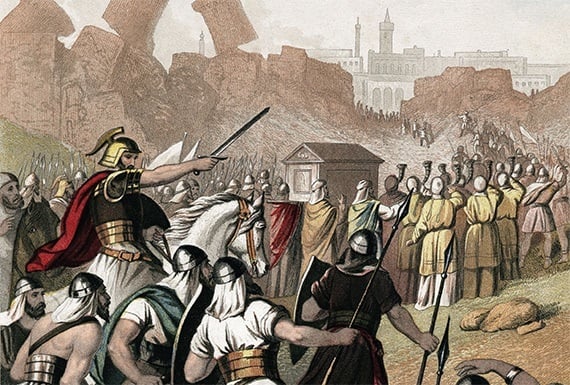This article first appeared in the Effective Evangelism column of the Christian Research Journal, volume 34, number 05 (2011). The full text of this article in PDF format can be obtained by clicking here.
Have you ever been in a discussion with a skeptic about God and morality? Perhaps you’ve admirably made the case that God’s good character is the basis for human dignity and worth. Maybe you’ve shown how objective moral values and duties can’t be explained naturalistically. Then someone takes the wind out of your sails by asking, “Well, if God is so good, why would He command Israel to engage in ethnic cleansing and genocidal warfare against the Canaanites? After all, doesn’t Deuteronomy 20:16–17 plainly state this? ‘Only in the cities of these peoples that the Lord your God is giving you as an inheritance, you shall not leave alive anything that breathes. But you shall utterly destroy them…as the Lord your God has commanded you.’”1 No matter how strongly the believer makes the case for the God-morality connection, this good argument can become overshadowed by the Canaanite question.
So what do we do? By all means, stick with the argument of how God’s existence makes better sense of a moral world in which intrinsically valuable persons exist! Yet we should be prepared to address this “genocide” question, which has gotten a lot more press since 9/11. “Religious radicalism” has emboldened New Atheists such as Richard Dawkins and Christopher Hitchens, who attack “the God of the Old Testament.” In our own experience, the Canaanite question is emerging with increasing frequency, and we will point out key response points.
First, we should avoid using the misleading statement “taking the Bible literally.” We don’t (and shouldn’t) always take it literally. We should always take it literarily. That is, we should treat the Bible’s types of literature (genres)—poetry, historical narrative, apocalypse, prophecy, parable—as they were intended to be interpreted. We can’t apply a one size-fits-all approach to each of them. This is particularly important for interpreting the Old Testament’s war texts properly—in their ancient Near Eastern setting.
Second, the sweeping language of these warfare texts such as Joshua (as well as Numbers 31 and 1 Samuel 15) occurs in highly figurative, hyperbolic accounts—quite common in the ancient Near East. This kind of “utterly destroyed” bravado was common in ancient Near Eastern war texts. Biblical scholars and archaeologists (e.g., K. Lawson Younger, Kenneth Kitchen) have recognized the pervasive use of hyperbolic language—“boasting” about “total destruction”—in ancient Near Eastern warfare literature. Victories were often described hyperbolically in terms of total conquest, complete annihilation, and destruction of the enemy, killing everyone and leaving no survivors. One Moabite king wrote of his defeat of Israel, “Israel is no more.” The knowing ancient Near Eastern reader recognized that this was massive hyperbole, and the accounts were not understood to be literally true. This language was like a basketball team saying of their opponents, “We totally slaughtered them!”
Third, the contrast between “utterly destroying” and leaving ample survivors is fairly obvious. In the biblical canon, Joshua is connected not only to Judges 1–2 (where lots of Canaanite survivors remain alive after Joshua “left no survivors”!), but also to Numbers and Deuteronomy. And Judges reveals that this widespread killing never literally happened, since there were swarms of Canaanites remaining. Even within Joshua we read, “There were no Anakim left in the land” (11:22); they were “utterly destroyed” in the hill country (11:21). Yet later in Joshua, Caleb asked permission to drive out the Anakites from the hill country (14:12–15; cf. 15:13–19). Joshua’s military campaign in Canaan simply wasn’t a territorial conquest, but a series of disabling raids.
In Numbers 31 (after Midianite women had intentionally seduced the men of Israel), we’re told, “[Israel] fought against Midian, as the Lord commanded Moses, and killed every man” (NIV, emphasis added). If literally true, why do we see Midianite multitudes in Judges 6:5? They were “like swarms of locusts. It was impossible to count them or their camels” (6:5 NIV). Also, the language is exaggerated in that every Midianite man was killed without a single Israelite fatality (Num. 31:50).
In 1 Samuel 15, Saul was commanded to “utterly destroy” the Amalekites. Stereotypical sweeping language was used: “Put to death both man and woman, child and infant, ox and sheep, camel and donkey” (15:3). On a literal reading, Saul carried this out—except for King Agag, who would meet his doom through the prophet Samuel (vv.7–9, 33). Yet this didn’t literally happen; the Amalekites were far from destroyed.
Exaggerated language is abundant. For instance, Saul’s army was numbered at 210,000—far larger than any army of antiquity. This was common in ancient Near Eastern war texts. In 1 Samuel 27:8–9, the same sweeping language of Chapter 15 is used: all Amalekites were wiped out—again! We’re told David invaded a territory full of Amalekites—the same territory covered by Saul. (Shur is near Egypt and Havilah is in Saudi Arabia—an area far too wide for Saul’s army to cover.) So, 1 Samuel 15 and 27 cannot both be literally true. What’s more, in 1 Samuel 30, a large Amalekite army attacked Ziklag (v. 1), and David pursued this army and fought a long battle with them, with four hundred Amalekites fleeing (1 Sam. 30:7–17). That’s not all: the Amalekites were even around during the reign of Hezekiah (1 Chron. 4:43).
So here’s the question: Why is it that virtually every time a narration of “genocide” occurs, it is followed by an account that presupposes it did not happen? Scripture took shape, and the Old Testament canon was formed. The final compiler or editor—who was certainly not mindless—saw no problem with side-by-side affirmations of “total destruction” and many surviving hostiles. He didn’t assume both to be literally true.
Fourth, the dominant language of “driving out” and “thrusting out” the Canaanites indicates further that “extermination” passages are hyperbolic (cf. Exod. 23:28; Lev. 18:24; Num. 33:52: Deut. 6:19; 7:1; 9:4; 18:12; Josh. 10:28, 30, 32, 35, 37, 39; 11:11, 14). Israel was to “dispossess” the Canaanites of their land (Num. 21:32; Deut. 9:1; 11:23; 18:14; 19:1). Just as Adam and Eve were “driven out” of the garden (Gen. 3:24), or Cain into the wilderness (4:14), or David from Israel by Saul (1 Sam. 26:19), so the Israelites were to “dispossess” the Canaanites. “Driving out” or “dispossessing” is different from “wiping out” or “destroying.” Clearly, utter annihilation was not intended; you can’t both drive out and destroy.
Fifth, the biblical language of the Canaanite “destruction” is identical to that of Judah’s destruction in the Babylonian exile—clearly not utter annihilation or even genocide. Indeed, God threatened to “vomit” out Israel from the land just as he had vomited out the Canaanites (Lev. 18:25, 28; 20:22). In the Babylonian invasion of Judah (sixth-century BC), God threatened to “lay waste the towns of Judah so no one can live there” (Jer. 9:11 NIV). Indeed, God said, “I will completely destroy them and make them an object of horror and scorn, and an everlasting ruin” (Jer. 25:9 NIV). God “threatened to stretch out My hand against you and destroy you” (Jer. 15:6; cf. Ezek. 5:16)—to bring “disaster” against Judah (Jer. 6:19). The biblical text, supported by archaeological discovery, suggests that while Judah’s political and religious structures were ruined and that Judahites died in the conflict, the urban elite were deported to Babylon while many “poor of the land” remained behind to inhabit the towns of Judah. Clearly, Judah’s being “completely destroyed” and made an “everlasting ruin” (Jer. 25:9) was a significant literary exaggeration—which reinforces our point about the Canaanite “destruction.”
Sixth, “Joshua obeyed all that Moses commanded” (Josh. 9:24; 11:12), and yet Joshua left many survivors. It only follows, then, that in Deuteronomy 20 Moses did not literally intend for no survivors to be left.
Why should the critic take the passage in Deuteronomy literally but not the passages in Joshua? If he took the latter literally it would be easier for him to see that in context the former is using hyperbole and should not be taken literally.
Seventh, archaeology confirms the biblical record’s account of a gradual infiltration rather than a massive military assault against the Canaanites. This was a development that took more than two centuries to accomplish. This being the case, all tangible aspects of the Canaanites’ culture—buildings and homes—would have remained very much intact (cf. Deut. 6:10–11: “cities which you did not build”). Preserving such structures would have been a very sensible move if Israel was to settle down in the same region. Archaeologists have discovered that by 1000 BC (during the Iron Age), Canaanites were no longer an identifiable entity in Israel. Around this time also, Israelites were worshiping a national God, whose dominant personal name was Yahweh (“the Lord”). An additional significant change from the Late Bronze to Iron Age was that town shrines in Canaan had been abandoned but not relocated elsewhere—say, to the hill villages. This suggests that a new people with a distinct theological bent had migrated there, had gradually occupied the territory, and eventually became dominant.
Thus, the critic’s strategy of emphasizing literal Canaanite annihilation while ignoring literal Canaanite survival is simply inconsistent.
— Paul Copan and Matthew Flannagan
Paul Copan, Ph.D., is Professor and Pledger Family Chair of Philosophy and Ethics at Palm Beach Atlantic University and is author of Is God a Moral Monster? Making Sense of the Old Testament God (Baker 2011).
Matthew Flannagan, Ph.D., has authored various articles and contributed to various books, including Set Forth Your Case (B&H Academic, forthcoming), and he and his wife Madeleine write the blog M and M, www.mandm.org.nz.
NOTES
- All Scripture quotations are from the NASB unless otherwise noted.









